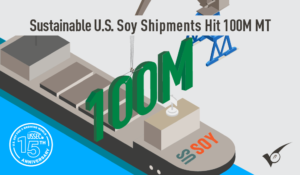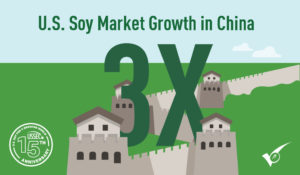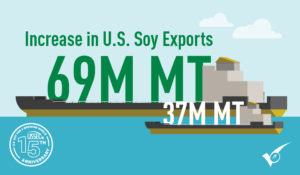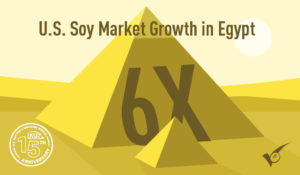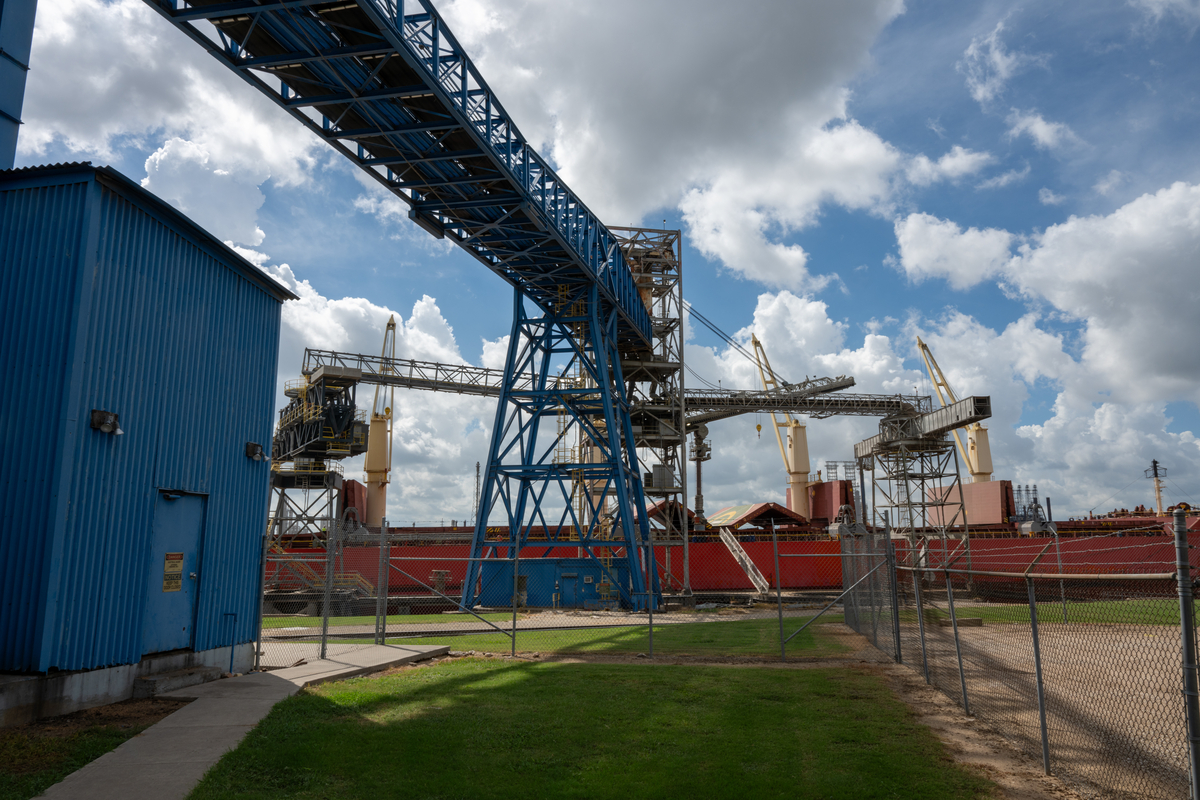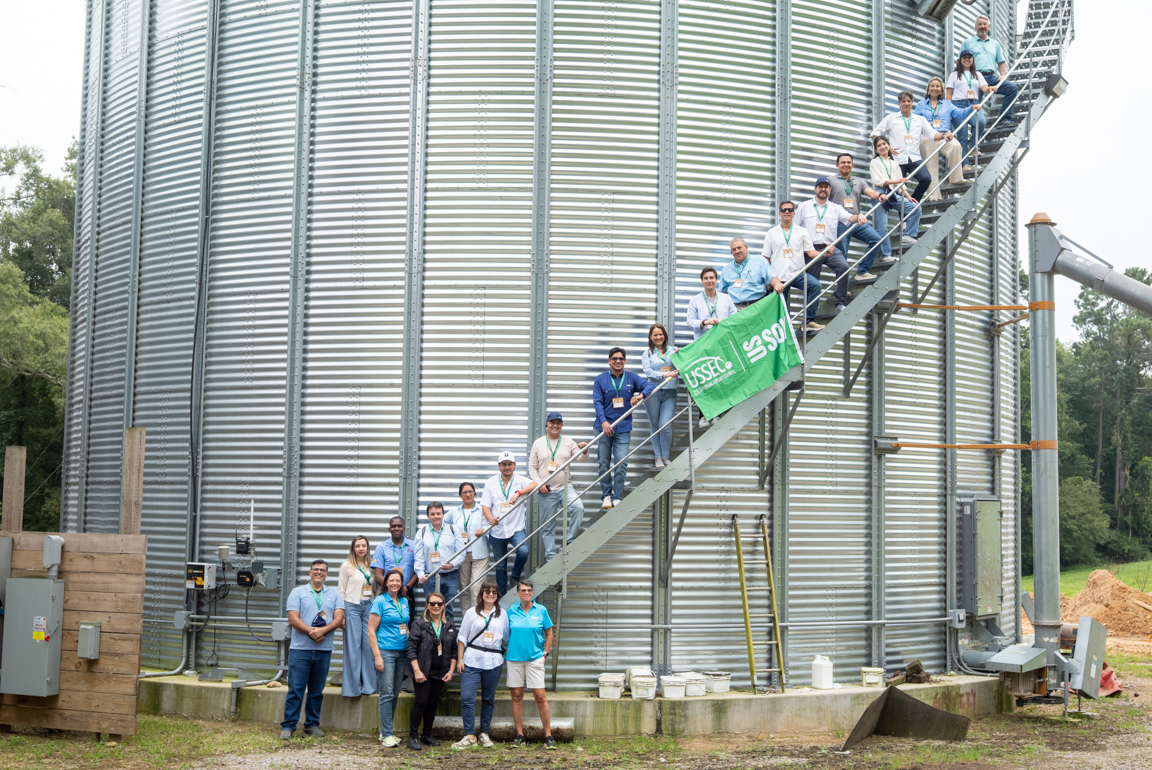Preference, Value, Accessibility: 15 Years with U.S. Soybean Export Council

Wins keep stacking up 15 years after farmer-leaders invested checkoff dollars in bolstering international soy exports.
In 2006, farmer-leaders from the American Soybean Association and the United Soybean Board, the farmers responsible for soy checkoff investments, formed the U.S. Soybean Export Council. Since its inception, USSEC has been devoted to building preference, improving value and enabling market access for the use of U.S. soy for human consumption, aquaculture and livestock feed.
USSEC is a dynamic partnership of U.S. soybean producers, processors, commodity shippers, merchandisers, allied agribusinesses and agricultural organizations. True to its charter, USSEC remains primarily farmer-funded through funds invested by the national checkoff and ASA along with various state soybean associations and boards. Additional funding comes from the food and agriculture industry, as well as ASA’s investment of cost-share funding provided by USDA Foreign Agricultural Service.
“To me, it’s clear that collaboration is the only way to make things happen, whether that looks like working with peers on the next farm or over on another continent,” says Monte Peterson, chairman of the USSEC board of directors and a farmer from Valley City, North Dakota. “We are optimistic about what’s on the horizon. While U.S. soybean farmers are doing their job of providing a sustainable and high-quality product, USSEC is working tirelessly to shape demand and access for high-quality, nutritious and sustainable U.S. soy and soybean products.”
- U.S. soybean exports have doubled in 15 years from just under 37 MMT to over 69 MMT.
- Fifty times growth in cumulative exports to Vietnam, Pakistan and Bangladesh at 3+ MMT vs. 60,000 MT.
- Sixty percent of U.S. soybeans are exported internationally, making it the U.S.’s No. 1 food and agriculture export.
- A cumulative 100 MMT of U.S. Soy Sustainability Assurance Protocol (SSAP)-verified shipments have been exported since the program launch in 2014.
On any given day, Jim Sutter, CEO of USSEC, visits with customers worldwide to further the mission of promoting U.S. soy. Sutter took the organization’s reins in 2010 and guided USSEC through a proactive reorganization of its global network of staff and offices to better represent the interests of U.S. soybean farmers.
“U.S. soybean farmers had the vision to invest internationally, and that’s meant that our organization continues to be focused on working in many different countries around the world to improve the nutrition and food security in the world’s most populous countries,” Sutter told an audience during the 2021 U.S. Soy Global Trade Exchange in St. Louis.
“Our USSEC team of seasoned market and technical experts provide an array of services and support to our food, feed and livestock industry customers,” says Timothy Loh, director of the Southeast Asia region, USSEC. “Our teams continue to build lasting partnerships one encounter, one meeting, one collaboration at a time, fortifying the close ties between U.S. Soy and the local industry and stakeholders in destination markets that is decades-strong — thus delivering ‘U.S. Soy for a growing world,’ and building a brand that international customers know and trust.”
Pandemic performance
That vision has held true even in the face of a worldwide pandemic. Since March 2020, USSEC representatives have held virtual meetings in 82 countries totaling 530 events with more than 61,000 participants.
“We touch 82 countries internationally, and our team is shaping a preference for and a value for U.S. soy,” Sutter says. “It’s been a key to the growth that we have seen in many of these markets.”
The largest trading partner for the U.S. is China. Over the last 40 years, U.S. farmers have worked to open the doors of trade with China. During the past 15 years, USSEC has invested in significant markets like China and identified emerging markets.
“It was 13 years before the first sale took place (in China),” Sutter says. “We have strong relationships with the industries in China. It is an important market for the U.S. It also gives us a road map to how we do work in other developing and emerging markets. We have many markets around the world that are following a similar gameplay.”
Building preference, expanding and diversifying
Historically, a majority of purchasing decisions were made on price alone. Now, consumers along with the food and feed industries are transitioning to a value-based approach, which is driving expansion for U.S. Soy.
USSEC ensures that our customers — from international food and feed to consumer goods and retail companies — understand the competitive advantages of choosing U.S. soy for its high quality, nutrient profile, digestibility, verified sustainability and reliable supply.
With USSEC’s marketing efforts and advances in nutritional science, several companies now have much more visibility into soy quality and how it affects the nutritional profile of their food and feed products, operating efficiency, profitability and sustainability.
USSEC also provides technical expertise and services to assist in market development, and collaborates in-country with food, edible oil, aquaculture and animal protein industries. A few of the tools USSEC has created are:
- The Soy Nutrient Value Calculator, which helps food and feed companies ensure they are delivering the highest value, most consistent and economical product to their customers.
- The Specialty U.S. Soy Database, an online tool for companies to choose U.S. soy varieties best suited to their application based on intended use, quality, composition and genetic characteristics.
- Soy Excellence Centers (SECs) around the world — in Egypt, Honduras, Thailand, Nigeria and a sister program in China — to help develop emerging markets.
“Through the exchange of ideas, science and on-the-job expertise, we work to build professionals and support their growth within the food and agricultural sectors,” Sutter adds. “The SEC help participants advance their careers and is a resource for business leaders to employ as a tool for talent development.”
There are currently four SECs and one more in planning stages. Each center is designed to serve as a regional hub for professional development and training, with courses, workshops and seminars led by industry-leading instructors.
“We think that we can make a difference in feeding the need for protein and essential fats and other nutrients around the world,” Sutter says. “U.S. soy is a healthy ingredient choice because it provides a scientifically proven better nutrient profile, increased digestibility and verified sustainability. This enables optimal performance and profitability for feed companies, livestock producers and food companies worldwide when compared to soy of other nations. We want to be a supplier of choice for all soy.”
Leading with sustainability
One strategic program USSEC developed to shape exports to countries worldwide has been the U.S. Soy Sustainability Assurance Protocol. U.S. soybean farmers, processors, commodity shippers, merchandisers and allied food and agriculture organizations, working together alongside nongovernmental organizations, jointly developed the independently audited SSAP.
“As more companies demand verified sustainably produced soy, it may interest you to know that over 100 million metric tons of U.S. Soy Sustainability Assurance Protocol-verified soy have been exported internationally over the seven years since the protocol was launched in 2014. U.S. acres in forests have actually gone up in the last 50 years, and our cropland has stayed about the same,” says Abby Rinne, director of sustainability, USSEC.
The SSAP is verified based on third-party, independent audits conducted by the U.S. Department of Agriculture, totaling about 20,000 independent audits conducted each year. The SSAP outlines and measures sustainable production practices, biodiversity, public health, labor practices and continuous improvement of farming practices.
“Recently, the Tokyo Olympic Games Organizing Committee recognized the U.S. Soy SSAP as compliant with its sustainable sourcing code for agricultural products, following recognition from the European Feed Manufacturers’ Federation and Consumer Goods Forum and the Global Seafood Alliance,” Rinne adds.
“U.S. soy farmers have pursued sustainable practices for decades for the benefit of their businesses, the planet and our society as a whole,” says Polly Ruhland, CEO of USB. “It’s farmers’ innate stewardship to grow more with less and sustain their land and soils for the next generation. The milestone of 100 million metric tons of SSAP-verified shipments is proof of how our farmers are striving to be global leaders in sustainability.”
USSEC staff and farmer-leaders are looking forward to the next 15 years. They believe they can increase global demand for U.S. soybeans and have the pieces in place to accomplish those goals.
“We’re going to continue to focus our efforts on diversifying markets that U.S. Soy touches in years to come,” Sutter says.
Countries such as Bangladesh, Vietnam, Indonesia, Pakistan and the Philippines will continue to be a focus for the organization. At the same time, Egypt and other countries in Southeast Asia and Africa can provide new growth opportunities.
“I think our U.S. farmers and U.S. exports are set up to make the U.S. the preferred supplier of choice for the world,” Sutter says.

